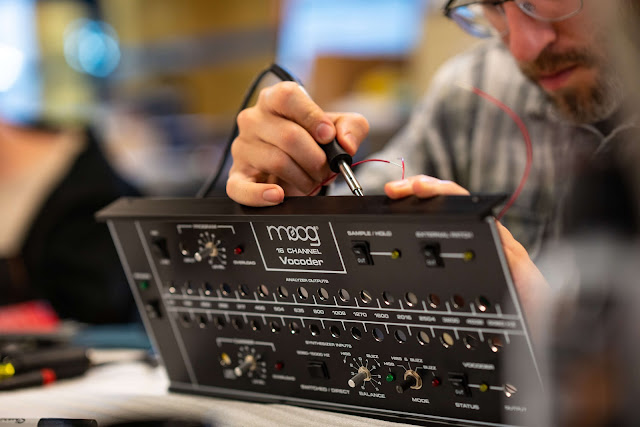Note: Auction links are affiliate links for which the site may be compensated.
via
this auction
See the original advert for the set in
this post.

via the seller: "THIS IS A ONCE IN A LIFETIME OPPORTUNITY FOR ANYONE TO OWN ALL THESE UNITS WITHOUT HAVING TO WAIT YEARS & YEARS TO FIND THEM ALL... IT TOOK ME MANY YEARS TO FIND THEM ALL AND SPENT LOTS OF MONEY ON THEM PLUS ALL THE ELECTRONIC MAINTENANCE I HAVE GIVEN TO EACH ONE OF THEM TO HAVE THEM WORK ALL 100%.
I have 5 units in a robust ATA Molded PE Shock w/ Rubber Shock Suspension (12U Space) Model: G-Shock-12L almost new with both front and back lid covers with it's own locking key as well... (REFER TO PHOTOS...) And the Moog Parametric Equalizer as a single unit because it didn't fit in the case unfortunately... But you get all 6 units shipped together as a complete set... NOTE: On the last picture the Bode Frequency Shifter, Bode Vocoder, and the second Moog Parametric EQ ARE NOT included in the bundle they are there just because that's where I had mounted both Parametric EQs but you only get one of the Parametric EQs and not 2 that are pictured there along with the other Bode stuff... Although the Bode Units are going for sale as well but are being sold separately so please refer to info description or ask questions if you're not sure. Thanks...

Here's what's included in the bundle:
- Moog 16 Channel Vocoder 327A - Model: MBVO - X 1 Unit
- Moog Custom Engineering String Filter - ( Fully Calibrated...) - X 1 Unit
- Moog Custom Engineering Dual VCO - ( Fully Calibrated As Well...) - X 1 Unit
- Moog 12 Stage Phaser - Model: MPKH - X 1 Unit
- Moog Three Band Parametric Equalizer 304A - Model: MKPE - X 1 Unit
- Moog Ten Band Graphic Equalizer - Model: MKGE - X 1 Unit
Here's some info you may want to know about each unit:
* Moog Dual VCO - The Moog Dual Voltage Controlled Oscillator was built in very limited quantities by the Moog Custom Engineering Department A.K.A. Modusonic which has 2 Ultra-Stable VCOs based on the 3rd Revision of the Minimoog 921A VCO With Temp Comp UA 726 Matched Differential Pair Transistors. SUPER FREAKING PHAT..!!! Personally I think it beats any Minimoog I've own... The waveforms are just "EARGASMIC"... =) You've got to hear it for yourself... The Moog Dual VCO was designed to add that extra two oscillator fatness to other Moog Synthesizers as the Multimoog, Micromoog and the Minimoog at the time; although the Minimoog required the addition of the Keyboard CV Output Modification so it could control the Moog Dual VCO's pitch and route it's output back into the Minimoog's External Audio Input... The Micromoog & Multimoog did not require this mod because they have already a Keyboard CV Output Jack as well as their respective audio input. So basically you can use the Moog Dual VCO with any Analog Synthesizer with a Keyboard CV Output (1 Volt/Oct.) and an External Audio Input to pass the Dual VCO's output signal back in it and voila two extra fat Moog Oscillators in your set up.
* Functions, Features & Input/Output Option:
- Master Tune - Controls overall tuning of both oscillators or one when only used as single...
- Pulse Width - Controls width of both oscillator's pulse waveforms when used either as single or dual.
- Octave Select Multi-Switch Knob with: LO, 32', 16', 8', 4', 2'. (Both Oscillator 1 & 2 have their own Multi-Switch Knob)
- Waveform Select Switch with: Up Ramp/Sawtooth, Triangle, Pulse, Sine.
- Oscillator On/Off Switch - Each Oscillator has it's own on/off switch to quickly add or subtract one oscillator while performing.
- Oscillator 2 Sync Switch - Automatically syncs both oscillators together by the flick of a switch.
- Oscillator 2 Tune Knob - To tune or detune oscillator 2 from 1 either while synced or un-synced.
- Output Level Knob - Controls overall output volume.
- Power Switch - Turns on/off unit.
- Oscillator 1 CV Input Jack 1/4" (1 Volt/Oct.) - Controls oscillator 1 only.
- Both In 1 CV Input Jack 1/4" (1 Volt/Oct.) - Controls pitch of both oscillators while oscillator 1 being the master controller.
- Oscillator 1 Output Jack 1/4" - Outputs signal of oscillator 1 only.
- Oscillator 2 CV Input Jack 1/4" (1 Volt/Oct.) - Controls oscillator 2 only.
- Both In 2 CV Input Jack 1/4" (1 Volt/Oct.) - Controls pitch of both oscillators.
- Oscillator 2 Output Jack 1/4" - Outputs signal of oscillator 2 only.
- X 4 Multiple Output Jacks 1/4" - Note: These are not connected whatsoever to any circuit inside the unit, they only serve to split any input or output signal you wish to multiply.
- Runs on 120 VAC Only.
* Moog 16 Channel Vocoder - The Moog 16 Channel Vocoder was designed by Genius Engineer and Pioneer In Electronic Music Instruments Harald Bode in the mid 70's about and first released in about 1977 under the "Bode Sound Company" Brand which was manufactured by Polyfusion under the name of Bode Vocoder 16 Channel Model 7702, and was then licensed to the Moog Synthesizer Brand in about 1978 which was then released as The Moog 16-Channel Vocoder 327A Model MBVO. Both Vocoders are almost identical in circuit design except for a few slight variations in the type of components that were used in each but functions and features are basically the same...
* Functions, Features & Input/Output Option:


















































